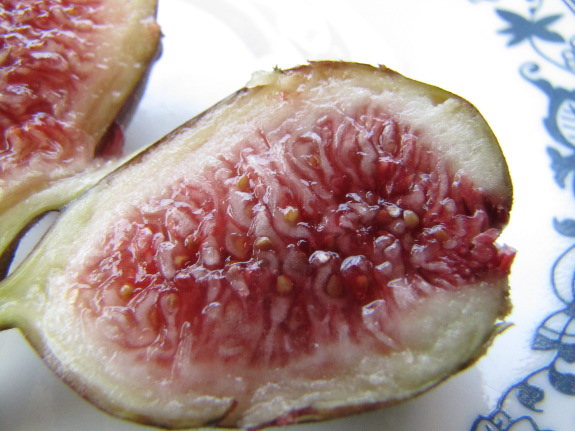Have you ever wondered what figs taste like?
Prepare to have your taste buds tantalized as we delve into the rich and diverse flavors of this delicious fruit.
From figgy sweetness to hints of melon and berry, figs offer a culinary experience like no other.
But that’s not all – these delectable treats are packed with nutrition and have even been known to tenderize meat.
So, whether you’re a fig aficionado or simply curious, join us on a flavorful journey to discover the wonders of this captivating fruit.
what do figs taste like
Figs taste sweet and moist, with a jelly-like and pulpy texture.
They have a base “figgy” flavor similar to dried fruits like raisins, dates, and persimmons.
Each fig variety has its own unique sugar flavor, such as honey, caramel, or cotton candy.
They also have a fruity flavor ranging from mild fruit punch to stronger flavors like raspberries or currants.
The taste can vary depending on the variety, with some having a nutty or melon-like flavor.
Figs are highly nutritious, containing natural sugars, soluble fiber, minerals, essential vitamins, and antioxidants.
They are particularly high in potassium and can act as a natural laxative.
However, they should be consumed moderately due to their high sugar content.
Figs can be enjoyed fresh, raw, or dried and can also be used in various recipes.
Key Points:
- Figs are sweet and moist with a jelly-like and pulpy texture.
- Their flavor is reminiscent of dried fruits like raisins, dates, and persimmons.
- Each fig variety has a distinct sugar flavor, such as honey, caramel, or cotton candy.
- They also have a fruity taste ranging from mild fruit punch to stronger flavors like raspberries or currants.
- Some fig varieties have a nutty or melon-like flavor.
- Figs are highly nutritious, containing natural sugars, soluble fiber, minerals, vitamins, and antioxidants.
what do figs taste like – Watch Video


Pro Tips:
1. Figs are technically not fruits but inverted flowers. The fruit-like part we eat is actually a mass of tiny flowers produced by fig trees.
2. Figs have a long history and were one of the first fruits ever cultivated. They were highly valued by ancient civilizations such as the Egyptians, Greeks, and Romans.
3. The taste of a fig can vary greatly depending on its ripeness and variety. Some figs have a sweet, honey-like flavor, while others may have a more intense, nutty taste.
4. Figs have a unique texture that combines chewiness with a slight crunchiness. The seeds inside can add an interesting crunch when eaten, similar to tiny edible seeds like those found in strawberries.
5. Figs are not only enjoyed fresh but are also transformed into a variety of delicious forms, including jams, syrups, and even dried figs. Dried figs have a rich, caramel-like flavor and are commonly used in desserts and baked goods.
A Sweet And Unique Flavor
Figs are known for their base “figgy” flavor, which can be likened to dried fruits such as raisins, dates, and persimmons. This distinctive taste sets figs apart from other fruits and gives them a unique culinary appeal.
When consumed fresh, figs have a luscious sweetness with a hint of natural sugars. Their flavor is often described as a delightful combination of honey and fruit.
The texture of figs is another aspect that adds to their appeal. When ripe, figs have a moist and jelly-like consistency, which further enhances their sweet and satisfying taste. This combination of flavors and textures makes figs a favorite among fruit lovers and adds a delicious touch to various dishes.
Underripe Figs – A Melon-Like Resin
While ripe figs are bursting with sweetness, underripe figs offer a unique taste experience of their own. Underripe figs have a slightly different flavor profile, with notes of melon and a resinous taste. This resinous flavor is reminiscent of unripe persimmons or green bananas and provides a refreshing twist to the fig’s overall taste.
As figs ripen, this resinous flavor gradually fades away, giving rise to a more pronounced sweetness. It is important to note that the degree of ripeness greatly impacts the taste of figs, so it can be interesting to explore the range of flavors that figs offer at different stages of ripeness.
- Underripe figs have a unique flavor profile
- Resinous taste reminiscent of unripe persimmons or green bananas
- Notes of melon add to the overall taste experience
- The resinous flavor fades as figs ripen, giving way to increased sweetness
The Fruitiness Of Figs: Mild To Strong
In addition to their base figgy flavor, figs also exhibit a fruitiness commonly referred to as “Berry.” This fruitiness can range from mild fruit punch-like flavors to stronger profiles reminiscent of raspberries or currants, adding depth and complexity to the overall taste of figs.
Here are some key points about the different fruit flavors found in fig varieties:
- Some figs have a sugar base with hints of fruity berry flavors.
- Others have a stronger melon and berry taste.
- Complex fig varieties can offer a delightful experience for those who enjoy intense berry flavors.
- These figs may have strong notes of raspberry, blackberry, currant, and/or honeyberry.
So, when it comes to figs, there is a wide range of fruit flavors to explore and enjoy.
Variety In Sugar Flavors: Honey, Caramel, Cotton Candy
Aside from their figgy and fruity flavors, figs also offer a range of sugar flavors that make each variety unique. Some figs have a distinct honey flavor that adds a natural sweetness to their taste. These figs are reminiscent of the delicate sweetness of honey, creating a harmonious blend of flavors.
Other fig varieties offer caramel-like or cotton candy flavors, further diversifying the sweetness that figs bring to the palate. These sugar flavors, combined with the fig’s natural sweetness, create a delightful taste sensation and make figs a versatile ingredient in various culinary creations.
The Three Common Flavor Profiles: Sugar, Honey, And Berry
When exploring the world of figs, three common flavor profiles emerge: Sugar, Honey, and Berry. Each fig variety falls into one or more of these profiles, offering a distinct combination of flavors that amplifies the overall taste experience.
Some figs have a predominantly sugar base with fruity berry flavors, enhancing their natural sweetness. Others possess a strong honey flavor, which adds a unique richness to the fig’s taste. Lastly, there are fig varieties with complex berry flavors, providing a prominent fruity experience reminiscent of berries like raspberries, blackberries, currants, or honeyberries.
Figs: Sweet, Moist, And Jelly-Like
One of the most prominent characteristics of figs is their inherent sweetness. Figs taste sweet and offer a burst of delicious natural sugars. Combined with their distinct figgy flavor, this sweetness makes figs a delightful treat that can be enjoyed on its own or incorporated into various dishes.
The texture of figs also greatly contributes to their overall appeal. When perfectly ripe, figs have a moist and jelly-like consistency. This texture adds depth and richness to the eating experience, amplifying the enjoyment of their sweet and fruity flavors.
- Figs are known for their inherent sweetness and burst of natural sugars.
- The distinct figgy flavor enhances their appeal.
- Perfectly ripe figs have a moist and jelly-like consistency, adding depth to the eating experience.
Nutty Or Fruity: Varying Flavors In Different Varieties
While figs generally have a sweet and fruity taste, the specific flavor can vary depending on the variety. Some figs exhibit nutty undertones, adding a subtle richness to their overall profile. The nutty flavor creates an interesting balance with the fig’s natural sweetness and enhances the complexity of the taste.
On the other hand, certain fig varieties emphasize the fruity aspect with strong notes of berries. These figs provide a bolder and more pronounced fruity experience, making them a perfect choice for those who admire intense fruit flavors. The flavor variation among fig varieties allows for a diverse culinary exploration and ensures there is a fig to suit every palate.
- Figs generally have a sweet and fruity taste.
- Flavor variation depends on the variety.
- Some figs have nutty undertones, adding richness to their profile.
- Other figs have strong notes of berries, providing a bolder fruity experience.
- Fig varieties cater to different taste preferences.
Nutritional Benefits Of Figs
Beyond their delightful taste, figs offer numerous nutritional benefits. They are a rich source of natural sugars, providing an energy boost and satisfying sweet cravings. Figs also contain soluble fiber, which aids digestion and contributes to a healthy digestive system.
Moreover, figs are packed with essential vitamins and minerals. They are particularly high in potassium, a mineral that plays a crucial role in maintaining healthy blood pressure levels. Figs also provide small amounts of protein and fiber, which contribute to overall well-being.
- Rich source of natural sugars
- Contains soluble fiber for digestion
- Packed with essential vitamins and minerals
- High in potassium for healthy blood pressure levels
- Provides small amounts of protein and fiber
“Figs offer a delightful taste along with numerous nutritional benefits.”
Moderation Is Key: High Sugar Content
While figs offer a range of health benefits, it is important to consume them in moderation due to their high sugar content. Although the sugars in figs are natural, excessive consumption can lead to an increase in blood sugar levels.
Individuals with diabetes or those following a low-sugar diet should be mindful of their fig intake.
By enjoying figs as part of a balanced diet, their nutritional benefits can be maximized without causing any adverse effects.
Incorporating figs into meals or using them as a natural sweetener in recipes is a great way to savor their flavors while also being mindful of their sugar content.
- Consume figs in moderation due to their high sugar content
- Natural sugars in figs can still elevate blood sugar levels
- Diabetic individuals and those on a low-sugar diet need to be cautious with fig intake
- Balanced intake of figs can maximize their nutritional benefits
- Use figs in meals or recipes as a natural sweetener
Enjoying Figs Fresh Or In Delicious Recipes
The best way to truly experience the flavor of figs is by plucking and enjoying them fresh. Eating figs as they are allows you to appreciate their natural sweetness, soft texture, and complex flavor profiles. Whether you are biting into a fig directly from the tree or adding them to a salad, the freshness of figs shines through in every bite.
In addition to enjoying figs fresh, they can also be used in various culinary preparations. Fig bruschetta, a delightful combination of crispy bread, creamy cheese, and sweet figs, is a crowd-pleasing appetizer. Fig jam is another popular choice, spreading the fig’s flavors on toast, pastries, or as an accompaniment to cheese.
Figs can also be consumed in dried form, offering a concentrated burst of sweetness. Dried figs are commonly used in baking, adding a natural sweetness to cakes, bread, and cookies. Furthermore, figs can be used to tenderize meat, adding a subtle sweetness and moisture to savory dishes.
The three common flavor profiles found in figs are:
- Sugar
- Honey
- Berry
Figs have a sweet and unique flavor that combines their base “figgy” taste with notes of honey, fruitiness ranging from mild to strong, and varying sugar flavors such as caramel and cotton candy. Figs are sweet, moist, and have a jelly-like texture that enhances their luscious taste. Their flavors can range from nutty to fruity, depending on the variety. Figs offer a range of nutritional benefits, but their high sugar content emphasizes the importance of moderation. Enjoying figs fresh or incorporating them into delicious recipes allows for a delightful culinary exploration and ensures that the flavors of figs are fully appreciated.
- Fresh figs offer natural sweetness, soft texture, and complex flavors.
- Fig bruschetta and fig jam are popular culinary preparations.
- Dried figs add concentrated sweetness to baked goods.
- Figs can be used to tenderize meat.
- Fig flavor profiles: Sugar, Honey, Berry.

You may need to know these questions about what do figs taste like
What do figs taste similar to?
Figs can be described as having a unique taste that is similar to other dried fruits like raisins, dates, and dried figs themselves. They possess a distinct “figgy” flavor that is rich and sweet. However, when it comes to under ripe figs, they can have a melon-like taste with a slightly resinous undertone. Additionally, figs can also exhibit a mild or strong fruitiness depending on their ripeness. Overall, figs offer a one-of-a-kind flavor experience that combines the sweetness of dried fruits with hints of melon and resin.
How would you describe the taste of a fig?
When you take a bite of a ripe fig, you are greeted with a delightful burst of sweetness reminiscent of rich honey. Its juicy nature releases a syrupy nectar that hints at the flavors of berries, while also offering a fresh undertone akin to a distinctive cookie.
Do you eat the skin on figs?
While the entire fig is indeed consumable, including the thin skin, it is ultimately a matter of personal preference whether to eat it or not. Some individuals may choose to peel the skin, but others find it perfectly enjoyable. Regardless, it is advised to wash the figs and remove the stems before consuming them. Overall, the decision to eat the skin on figs depends on individual taste and texture preferences.
Are figs healthy?
Figs are indeed a good addition to a healthy diet. They are a rich source of calcium and potassium, minerals that are vital for maintaining strong bones. These two minerals work synergistically to enhance bone density, potentially reducing the risk of osteoporosis. Research indicates that consuming a diet high in potassium can contribute to improved bone health and decrease bone turnover. Therefore, incorporating figs into your regular meals can be a delicious way to support bone strength and overall well-being.
Reference source
https://simpleandsavory.com/what-do-figs-taste-like/
https://www.figboss.com/figflavors
https://www.npr.org/2008/09/10/94391625/perfection-is-a-fresh-fig
https://www.youtube.com/watch?v=qQOzHnXnLbY



